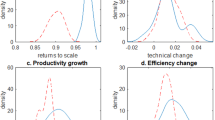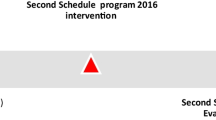Abstract
In some contexts, firms have to deal with certain elements or factors that affect the production outcome but which are non-market in nature and therefore do not have a price. In this paper we propose a new use of a production economics tool, the input distance function, to empirically measure the effects of these factors. Although we suggest a general use of this methodology, it has been developed in the context of measuring the effects of labor disputes in a particular declining industry, that of Spanish coal mining. We have estimated an equation system comprising an input distance function and cost share equations to calculate the cost generated by strikes.



Similar content being viewed by others
Notes
The interested reader in this specific case can consult Del Rosal (2000).
Del Rosal and Fonseca (2001) show that a statistical relationship can be detected between labor unrest (measured in lost working days) and certain variables that can be considered as proxies for activity adjustment such as lost employment or pit closures.
Leaving aside theoretical discussions like “efficient rent-seeking” and what could be called “the search for the lost rectangle”, there have been attempts to quantify the social waste due to rent-seeking behavior, sometimes using ad hoc measures (Laband and Sophocleus 1992, for instance) and at other times using econometric regressions to study the correlation between agents’ transfers and other explanatory variables “suggested by theory” (see, for instance, Laband and Sophocleus 1988; Lopez and Pagoulatos 1994; Lenway et al. 1996).
In fact, the link between rent seeking and efficiency is not new. While it has not been developed, it has been suggested. This quotation from Tullock (1997, p. 152) can be illuminating: “... in many cases, as part of the lobbying activities, the company that seeks the special privilege is forced to engage in some kind of inefficient production method in order to conceal the privilege”.
Using the methodology proposed we can also check whether labor rents exist or not, i.e., if there is a supra-competitive wage.
Alternatively, a dual profit or revenue function could be considered. Given the aim of this paper we restrict our analysis to an input orientation.
For more details see Rodríguez-Alvarez and Lovell (2004).
Note that, due to the definition of variable H, the homogeneity conditions have to be modified. The new conditions are: \({\beta_{L}+\beta_{M} =1; \beta_{LL}+\beta_{LH}+\beta_{HH}+\beta_{LM}+\beta_{HM}=0; \beta_{ML}+\beta_{MM}+\beta_{MH}=0; \rho_{YL}+\rho_{YM}+\rho_{YH}= 0; \xi_{HL}+\xi_{HM}+\xi_{HH}= 0; \eta_{KL}+\eta _{KM}+\eta_{KH}= 0; \Psi_{TL}+\Psi_{TM}+\Psi_{TH}=0.}\)
For example, a mining accident will cause a stoppage of the production process, and the reduction of labor and materials will be the same, as long as the materials are used by the workers.
The estimated input distance function is increasing in variable inputs and decreasing in the output for all observations. Note also that given we have only two inputs and given that we have imposed linear homogeneity, we are imposing that the input distance function is quasi-concave.
To ensure consistency when aggregating the share equations, the coefficients a L and a M need to sum to zero. In our case, as we have only two inputs, a L = − a M .
References
Atkinson SE, Cornwell Ch, Honerkamp O (2003) Measuring and decomposing productivity change: stochastic distance function estimation versus data envelopment analysis. J Bus Econ Stat 21(2):284–294
Atkinson SE, Dorfman JH (2005) Bayesian measurement of productivity and efficiency in the presence of undesirable outputs: crediting electric utilities for reducing air pollution. J Econom 126(2):445–468
Ball VE, Lovell CAK, Nehring RF (1994) Incorporating undesirable outputs into models of production: an application to U.S. agriculture. Cahiers d’Economique et Sociologie Rurales 3:59–73
Baldwin RE (1984) Rent-seeking and trade policy: an industrial approach. Weltwirtschaftliches Archiv 12:662–677
Berndt ER (1991) The practice of econometrics. Classic and contemporary. Addison-Wesley, Reading, MA
Buchanan JM (1980) Rent seeking and profit seeking. In: Buchanan JM, Tollison RD, Tullock G (eds) Toward a theory of rent-seeking society. Texas A&M University Press, Texas
Coelli T, Perelman S (1996) Efficiency measurement, multiple-output technologies and distance functions: with application to European railways. CREPP Working Paper 96/05, Université de Liège
Coelli T, Perelman S (2000) Technical efficiency of European railways. A distance function approach. Appl Econ 32(15):1967–1976
Coelli T, Prasada Rao DS, Battese GE (1998) An introduction to efficiency and productivity analysis. Kluwer, Boston
De Koeijer TJ, Wossink GA, Struik PC (2002) Measuring agricultrual sustainability in terms of efficiency: the case of Dutch sugar beet growers. J Environ Manage 6:9–17
Del Rosal I (2000) How costly is the maintenance of the coal-mining jobs in Europe? The Spanish case 1989–1995. Energy Policy 28(8):537–547
Del Rosal I, Fonseca A (2001) Rent-seeking measurement by means of labor unrest in trade related adjustment processes. A note. Appl Econ Lett 8:273–277
Färe R, Grosskopf S (1995) Nonparametric tests of regularity, Farrell efficiency, and goodness-of-fit. J Econom 6:415–425
Färe R, Grosskopf S (1998) Shadow pricing of good and bad commodities. Am J Agric Econ 8:584–590
Färe R, Primont D (1995) Multi-output production and duality: theory and applications. Kluwer Academic Publishers, Norwell
Färe R, Grosskopf S, Lovell CAK, Pasurka C (1989) Multilateral productivity comparisons when some outputs are undesirable: a nonparametric approach. Rev Econ Stat 7:90–98
Färe R, Grosskopf S, Lovell CAK, Yaisawarng S (1993) Derivation of shadow prices for undesirable outputs: a distance function approach. Rev Econ Stat 7:374–380
Ferrier G, Lovell CAK (1990) Measuring cost efficiency in banking: econometric and linear programming evidence. J Econom 4:229–245
Gallant AR (1975) Seemingly unrelated nonlinear regressions. J Econom 3:35–50
Graham M (2004) Environmental efficiency: meaning and measurement and application to Australian dairy farms. AARES, 48th Annual conference of the Australian Agricultural and Resource Economics Society, Melbourne, pp 1–18
Grosskopf S, Hayes K, Taylor L, Weber W (1997) Budget constraint frontier measures of fiscal equality and efficiency in schooling. Rev Econ Stat 7:116–124
Hetemäki L (1996) Essays on the impact of pollution control on a firm: a distance function approach. Finnish Forest Research Institute, Research Papers 609
Higgins RS, Tollison RD (1988) Life among the triangles and trapezoids: notes on the theory of rent-seeking. In: Rowley CK, Tollison RD, Tullock G (eds) The political economy of rent-seeking. Kluwer, Boston
Krueger AO (1974) The political economy of the rent seeking society. Am Econ Rev 6:291–303
Laband DN, Sophocleus JP (1988) The social cost of rent-seeking: first estimates. Public Choice 5:269–275
Laband DN, Sophocleus JP (1992) An estimate of resource expenditures on transfer activity in the United States. Q J Econ 10:959–983
Lenway S, Morck R, Yeung B (1996) Rent seeking, protectionism and innovation in the American steel industry. Econ J 10:410–421
Lewis HG (1986) Union relative effects: a survey. University of Chicago Press, Chicago
Lopez R, Pagoulatos E (1994) Rent seeking and the welfare cost of trade barriers. Public Choice 7:149–160
Messemer C, Parks RW (2004) Bootstrap methods for inference in a SUR model with autocorrelated disturbances. University of Washington Economics, Working Paper No. UWEC-2004-24
McNutt PA (1996) The economics of public choice. Edward Elgar, Cheltenham
MacKinnon G (2002) Bootstrap inference in econometrics. Can J Econ 3:615–645
Pittman R (1983) Multilateral productivity comparisons with undesirable outpus. Econ J 9:883–891
Reinhard S, Lovell CAK, Thijssen G (1999) Econometric estimation of technical and environmental efficiency: an application to Dutch dairy farms. Am J Agric Econ 8:44–60
Reinhard S, Lovell CAK, Thijssen G (2002) Analysis of environmental efficiency variation. Am J Agric Econ 8:1054–1065
Rilstone P, Veall M (1996) Using bootstrapped confidence intervals for improved inferences with seemingly unrelated regression equations. Econom Theory 12(3):569–80
Rodríguez-Álvarez A, Lovell CAK (2004) Excess capacity and expense preference behavior in National Health Systems: an application to the Spanish Public Hospitals. Health Econ 13(2):157–169
Roibas D, Arias C (2004) Endogeneity problems in the estimation of multi-output technologies. Efficiency Series Paper 6/2004, University of Oviedo
Rowley CK, Tollison RD, Tullock G (eds) (1988) The political economy of rent-seeking. Kluwer, Boston
Shephard RW (1953) Cost and production functions. Princeton University Press, Princeton
Shephard RW (1970) Theory of cost and production functions. Princeton University Press, Princeton
Sickles RC, Good DH, Getachew L (1996) Specification of distance functions using semi- and non-parametric methods with an application to the dynamic performance of Eastern and Western European Air Carriers. 2nd Biennial Georgia Productivity Workshop, University of Georgia
Tyteca D (1996) On the measurement of the environmental performance of firms: a literature review and a productive efficiency perspective. J Environ Manage 4:281–308
Tullock G (1967) The welfare costs of tariffs, monopoly and theft. Western Econ J 3:224–232
Tullock G (1997) Where is the rectangle? Public Choice 9:149–159
White H (1980) A heteroskedasticity-consistent covariance matrix and a direct test for heteroskedasticity. Econometrica 4:721–746
Acknowledgments
The authors would like to thank Shawna Grosskopf and two anonymous referees for their detailed comments and suggestions on earlier versions of the paper. We are also indebted to Alan Wall for assistance in the manuscript preparation. Financial support was provided by the University of Oviedo (Grant IR-01-511-1).
Author information
Authors and Affiliations
Corresponding author
Rights and permissions
About this article
Cite this article
Rodríguez-Álvarez, A., Rosal, I.d. & Baños-Pino, J. The cost of strikes in the Spanish mining sector: modelling an undesirable input with a distance function. J Prod Anal 27, 73–83 (2007). https://doi.org/10.1007/s11123-006-0023-5
Published:
Issue Date:
DOI: https://doi.org/10.1007/s11123-006-0023-5




